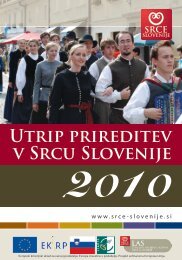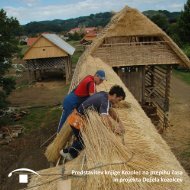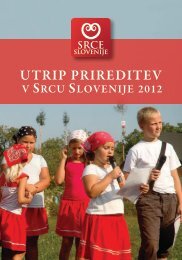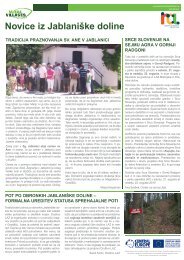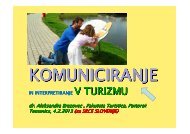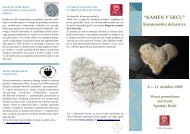Naše kulturno bogastvo - Razvojni center Srca Slovenije
Naše kulturno bogastvo - Razvojni center Srca Slovenije
Naše kulturno bogastvo - Razvojni center Srca Slovenije
- No tags were found...
You also want an ePaper? Increase the reach of your titles
YUMPU automatically turns print PDFs into web optimized ePapers that Google loves.
Plaiting straw braidsPlaiting straw braids is the basis forthe straw-related craft which hasalmost disappeared in the area ofDomžale over the last ten years.Straw hats used to be highly appreciatedby various social classesand particularly professions suchas for example that of a salt-workerin our saltpans at the seaside. The300 year-old straw hat traditionis presented in the unique StrawHat Museum in Domžale, where ademonstration of plaiting and sewingof straw hats is possible by priorarrangement.Plaiting straw braids started to developas a characteristic home craft in the 18 thcentury in the area of Ihan, and in the19 th century it spread to the surroundingplaces in the areas of Domžale,Lukovica, Mengeš, Kamnik, Dol nearLjubljana, Moravče and Trzin. In the hillyareas braid plaiting dominated, whileon the plains straw hats were sewnand in the factories they were finalisedand sent to the market. Since the finalproducts depended considerably onthe semi-products it was necessary tofirst separate braid plaiting from sewingand shaping of straw hats. Today onlysome societies and some individualsare involved in this activity; plaitingstraw braids connects most closely thefemale members of the Cultural andArts Society Fran Maselj Podlimbarskifrom Krašnja near Lukovica.The straw for braids used to be selectedafter the crop had been hand-reaped.The best of straw was pulled out of thesheaves, then threshed to separate thestraw from the grains and sheavedpušeljne (i.e. sheaves; translator’ note)which they then put in the sun to dry.They had to be careful as the straw mustnot get wet because of rain otherwisespots would appear on it. After the strawhad dried the ears were cut off, it wasstored in the attic where it remaineduntil winter. In winter when there wasno field work to do mainly womenplaited surrounded by their families,with neighbours and sometimes oneof them hosted the others and togetherthey created straw braids.Before plaiting was begun, the strawwas prepared for plaiting in a certainmanner. It was cleaned, i.e. freed of anyimpurities, cut at the first kolenec (atthe first thickened part of the hollowstalk; translator’s note) and distributedaccording to its thickness. Before theystarted to plait, the straw was put intowater. Plaiting did not bring a lot ofmoney. The braids plaited from the thinneststraws were the most expensive.Most braids were made of seven strawsas these braids were use to make strawhats and narrow, two-handled bags.Braids were also of more straws, evenas many as twenty-one. The plaitedbraid was coiled around a small boardwhich was called a komolec (unit oflength – 44cm; translator’s note). Whena braid was thirty-six komolci or eighteenmetres long it was taken off thekomolec and tied. Every week a kitar (abraidman; translator’s note) came totake them to the factories where strawhats were made. One braid was neededfor a straw hat, for larger ones morebraids were used.In 1985 a teacher, Vera Beguš, gave theinitiative to revive the craft of plaitingbraids. This was done with the assistanceof the Cultural and Arts SocietyFran Maselj Podlimbarski. Thus theywanted to raise the interest for a homecraft which used to be highly developedand entice people to enjoy sociallife more. Today plaiting is again verypopular in Krašnja: many children learnthe craft at the local elementary school.The members of the Society do notbuy the straw, they obtain it accordingto the method, i.e. by hand-reaping inthe nearby fields. More than 20 womenin the Society plait, sixteen of themhave been demonstrating their craftat various events and fairs throughoutSlovenia. Children who have alreadylearnt the skill well often join them. TheSociety does not have premises of theirown, they all learn in the village elementaryschool. Braids are made, similar tothose of so many years ago; which arethen taken to Domžale to the retiredJoža Košak: her skilful fingers master thecraft of making baskets, narrow, twohandledbags and straw hats.55




